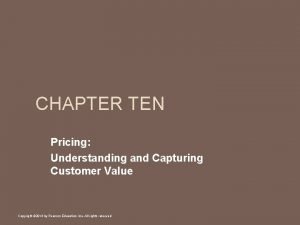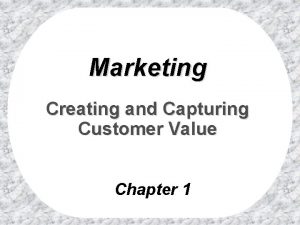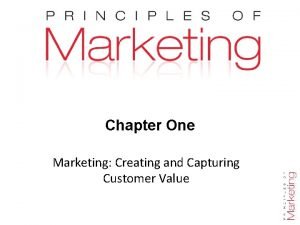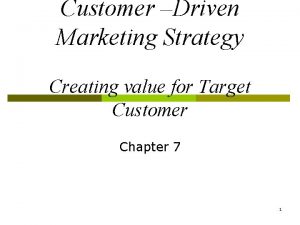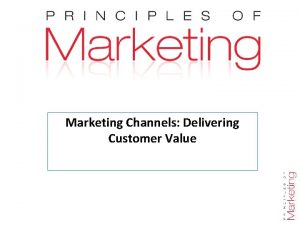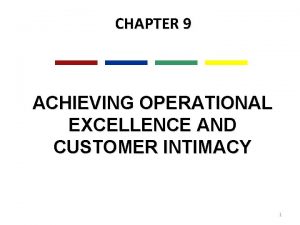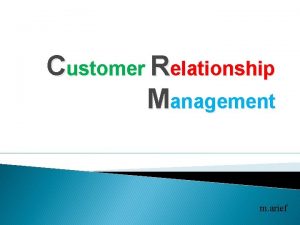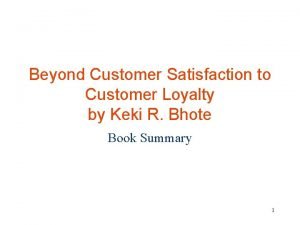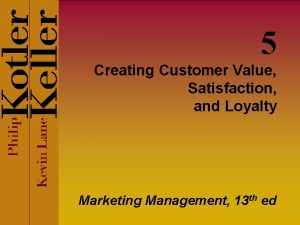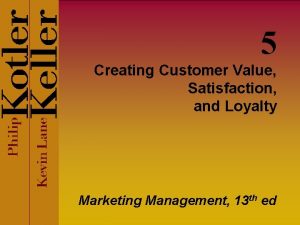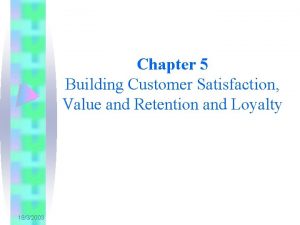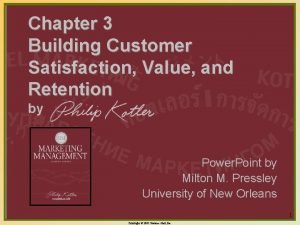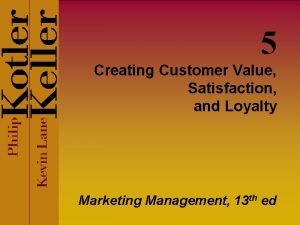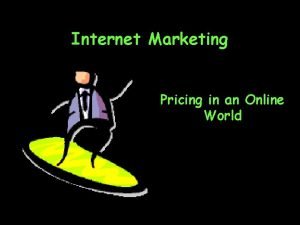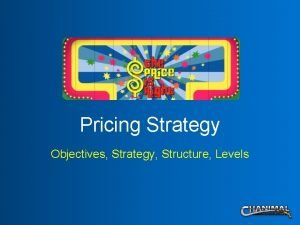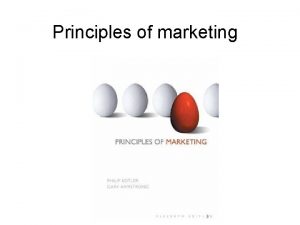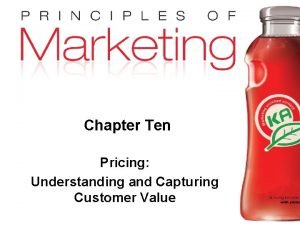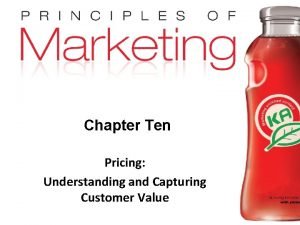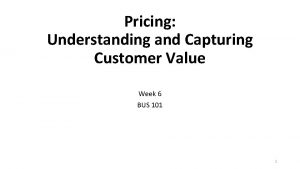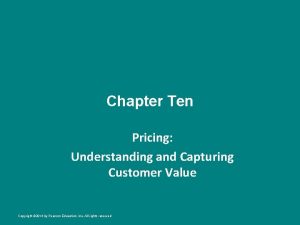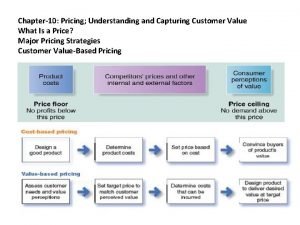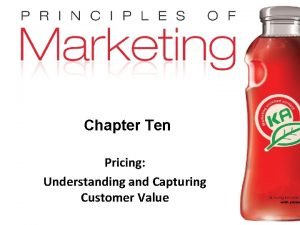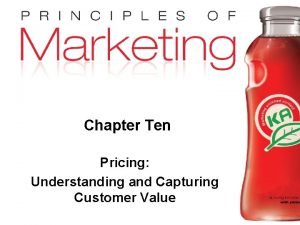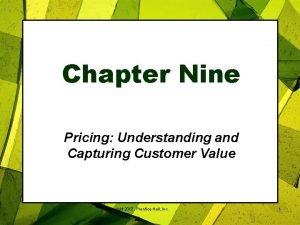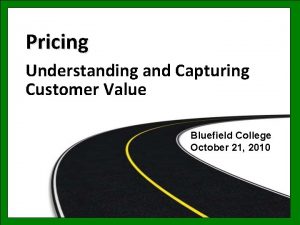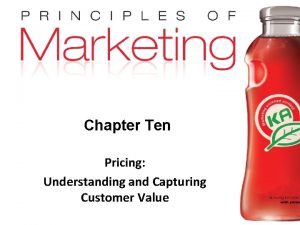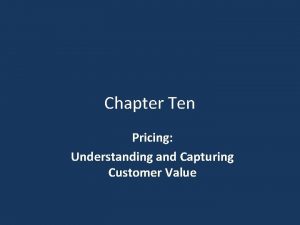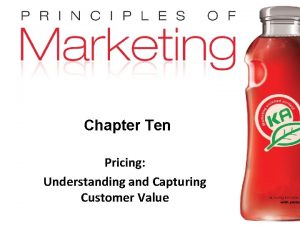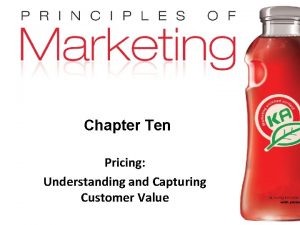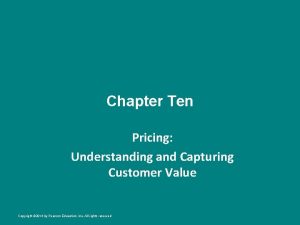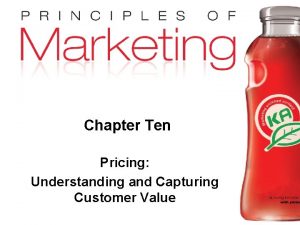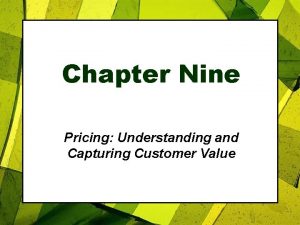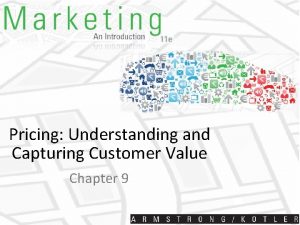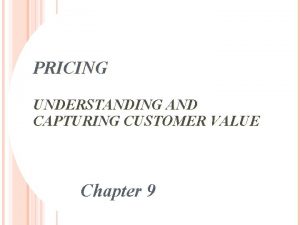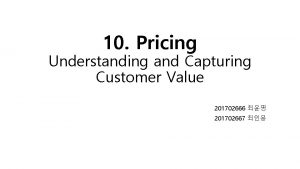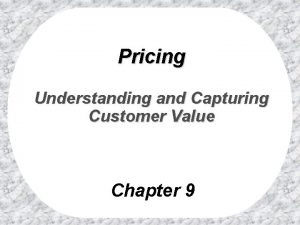Marketing Pricing Understanding and Capturing Customer Value 1












































- Slides: 44

Marketing Pricing Understanding and Capturing Customer Value

1 -What Is a Price? �In the narrowest sense, price is the amount of money charged for a product or a service. �More broadly, price is the sum of all the values that customers give up to gain the benefits of having or using a product or service. �Price has been the major factor affecting buyer choice, but nonprice factors have gained increasing importance. �However, price still remains one of the most important elements that determines a firm’s market share and profitability. �Price is the only element in the marketing mix that produces revenue; all other elements represent costs. �Price is also one of the most flexible marketing mix elements. § Unlike product features and channel commitments, prices can be changed quickly.

1 -What Is a Price? � The pricing is number-one problem facing many marketing executives, and many companies do not handle pricing well. �Smart managers treat pricing as a key strategic tool for creating and capturing customer value: ü Prices have a direct impact on a firm’s bottom line. ü A small percentage improvement in price can generate a large percentage increase in profitability. �More importantly, as part of a company’s overall value proposition, price plays a key role in creating customer value and building customer relationships.

2 -Major Pricing Strategies The price the company charges will fall somewhere between one that is: I. I. II. Too high to produce any demand, Too low to produce a profit. Customer perceptions of the product’s value set the ceiling for prices. II. I. If customers perceive that the product’s price is greater than its value, they will not buy the product. III. Product costs set the floor for prices. I. If the company prices the product below its costs, the company’s profits will suffer. �In setting its price between these two extremes, the company must consider several internal and external factors, including: § Competitors’ strategies and prices, the overall marketing strategy and mix, and the nature of the market and demand. �Figure 10. 1 suggests three major pricing strategies: customer value -based pricing, cost based pricing, and competition-based pricing.


2 -Major Pricing Strategies ØCustomer Value-Based Pricing �In the end, the customer will decide whether a product’s price is right. § Effective, customer-oriented pricing involves understanding how much value consumers place on the benefits they receive from the product and setting a price that captures this value. �Customer Value-based Pricing uses buyers’ perceptions of value, not the seller’s cost, as the key to pricing. § Value-based pricing means that the marketer cannot design a product and marketing program and then set the price. �Price is considered along with all other marketing mix variables before the marketing program is set. �Figure 10. 2 compares value-based pricing with cost-based pricing. �Although costs are an important consideration in setting prices, cost-based pricing is often product driven.


2 -Major Pricing Strategies Customer Value-Based Pricing �Marketing must then convince buyers that the product’s value at that price justifies its purchase. �If the price turns out to be too high, the company must settle for lower markups or lower sales, both resulting in disappointing profits. �Value-based pricing reverses this process. § The company first assesses customer needs and value perceptions. § It then sets its target price based on customer perceptions of value. �The targeted value and price drive decisions about what costs can be incurred and the resulting product design. �As a result, pricing begins with analyzing consumer needs and value perceptions, and the price is set to match perceived value.

2 -Major Pricing Strategies Customer Value-Based Pricing �It’s important to remember that “good value” is not the same as “low price. ” § For example, a Steinway piano—any Steinway piano—costs a lot. § But to those who own one, a Steinway is a great value. �To such customers, whatever a Steinway costs, it’s a small price to pay for the value of owning one. “A Steinway takes you places you’ve never been, ” says an ad. �Companies often find it hard to measure the value customers will attach to its product. § For example, calculating the cost of ingredients in a meal at a fancy restaurant is relatively easy, but assigning value to other satisfactions such as taste, environment, relaxation, conversation, and status is very hard.

2 -Major Pricing Strategies Customer Value-Based Pricing �Still, consumers will use these perceived values to evaluate a product’s price, so the company must work to measure them. § If the seller charges more than the buyers’ perceived value, the company’s sales will suffer. § If the seller charges less, its products sell very well, but they produce less revenue than they would if they were priced at the level of perceived value. �There are two types of Value-based Pricing: § Good-Value Pricing and § Value-added Pricing.

2 -Major Pricing Strategies ØGood-Value Pricing �Good-value Pricing strategies—offering the right combination of quality and good service at a fair price. �In many cases, this has involved introducing less-expensive versions of established, brand-name products. § Such as Taco Bell and Mc. Donald’s offer value meals and dollar menu items, Armani offers the less-expensive, more-casual Armani Exchange fashion line. �In other cases, good-value pricing has involved redesigning existing brands to offer more quality for a given price or the same quality for less. § For example, passengers flying the low-cost European airline. �An important type of good-value pricing at the retail level is everyday low pricing (EDLP)*. �In contrast, high-low pricing** involves charging higher prices on an everyday basis but running frequent promotions to lower prices temporarily on selected items.

2 -Major Pricing Strategies �Value-Added Pricing �Instead, many companies adopt value-added pricing* strategies rather than cutting prices to match competitors, they attach value-added features and services to differentiate their offers and thus support higher prices. § For example, at a time when competing restaurants lowered their prices and screamed “value” in a difficult economy, fast-casual chain Panera Bread** has prospered by adding value and charging accordingly. � The Stag was threatened by cheaper imports from China, Stag responded by dropping prices and scrimping on quality, it was a bad move; the brand began losing money, however, Stag came to its senses, abandoned the price war and started innovating. �“If consumers thought the best deal was simply a question of money saved, we’d all be shopping in one big discount store, ” says one pricing expert: § “Customers want value and are willing to pay for it, § Savvy marketers price their products accordingly. ”

2 -Major Pricing Strategies ØCost-Based Pricing �Customer-value perceptions set the price ceiling, costs set the floor for the price that the company can charge. �Cost-based pricing involves setting prices based on the costs for producing, distributing, and selling the product plus a fair rate of return for its effort and risk. �A company’s costs may be an important element in its pricing strategy. �Companies with lower costs can set lower prices that result in smaller margins but greater sales and profits. �Other companies—such as Apple, BMW, and Steinway— intentionally pay higher costs so that they can claim higher prices and margins. �The key is to manage the spread between costs and prices—how much the company makes for the customer value it delivers.

2 -Major Pricing Strategies ØTypes of Costs � A company’s costs take two forms: fixed and variable. � Fixed Costs: (also known as overhead) are costs that do not vary with production or sales level. § For example, a company must pay each month’s bills for rent, heat, interest, and executive salaries—whatever the company’s output. � Variable Costs: vary directly with the level of production, these costs tend to be the same for each unit produced, they are called variable costs because the total varies with the number of units produced. § Each PC produced by HP involves a cost of computer chips, wires, plastic, packaging, and other inputs. � Total Costs: are the sum of the fixed and variable costs for any given level of production. � Management wants to charge a price that will at least cover the total production costs at a given level of production. § The company must watch its costs carefully, if it costs the company more than its competitors to produce and sell a similar product, the company will need to charge a higher price or make less profit, putting it at a competitive disadvantage.

2 -Major Pricing Strategies ØCosts at Different Levels of Production �To price wisely, management needs to know how its costs vary with different levels of production. § For example, suppose Texas Instruments (TI) built a plant to produce 1, 000 calculators per day. �Figure 10. 3 A shows the typical short-run average cost curve (SRAC). § It shows that the cost per calculator is high if TI’s factory produces only a few per day, but as production moves up to 1, 000 calculators per day, the average cost per unit decreases. �This is because fixed costs are spread over more units, with each one bearing a smaller share of the fixed cost. § TI can try to produce more than 1, 000 calculators per day, but average costs will increase because the plant becomes inefficient, workers have to wait for machines, the machines break down more often, and workers get in each other’s way.


2 -Major Pricing Strategies Costs at Different Levels of Production �If TI believed it could sell 2, 000 calculators a day, it should consider building a larger plant. �The plant would use more efficient machinery and work arrangements: § The unit cost of producing 2, 000 calculators per day would be lower than the unit cost of producing 1, 000 units per day, as shown in the long-run average cost (LRAC) curve (Figure 10. 3 B). § In fact, a 3, 000 -capacity plant would be even more efficient, according to Figure 10. 3 B. § But a 4, 000 -daily production plant would be less efficient because of increasing diseconomies of scale—too many workers to manage, paperwork slowing things down, and so on. �Figure 10. 3 B shows that a 3, 000 -daily production plant is the best size to build if demand is strong enough to support this level of production.


2 -Major Pricing Strategies ØCosts as a Function of Production Experience �Suppose TI runs a plant that produces 3, 000 calculators per day. § As TI gains experience in producing calculators, it learns how to do it better. § Workers learn shortcuts and become more familiar with their equipment. § With practice, the work becomes better organized, and TI finds better equipment and production processes. �With higher volume, TI becomes more efficient and gains economies of scale. �As a result, the average cost tends to decrease with accumulated production experience, this is shown in Figure 10. 4. § The average cost of producing the first 100, 000 calculators is $10 per calculator. § When the company has produced the first 200, 000 calculators, the average cost has fallen to $8. 50.


2 -Major Pricing Strategies Costs as a Function of Production Experience § After its accumulated production experience doubles again to 400, 000, the average cost is $7. �This drop in the average cost with accumulated production experience is called the experience curve (or the learning curve). § If a downward-sloping experience curve exists, this is highly significant for the company, the company’s unit production cost fall, but it will faster if the company makes and sells more during a given time period. �But the market has to stand ready to buy the higher output, and to take advantage of the experience curve, TI must get a large market share early in the product’s life cycle. �This suggests the following pricing strategy: § TI should price its calculators low; its sales will then increase, and its costs will decrease through gaining more experience, and then it can lower its prices further.

2 -Major Pricing Strategies Costs as a Function of Production Experience v. Cost-Plus Pricing �The simplest pricing method is cost-plus pricing (or markup pricing )—adding a standard markup to the cost of the product. § Construction companies, for example, submit job bids by estimating the total project cost and adding a standard markup for profit. v. Break-Even Analysis and Target Profit Pricing �Another cost-oriented pricing approach is break-even pricing (or target return pricing). �The firm tries to determine the price at which it will break even or make the target return it is seeking. �Target return pricing uses the concept of a break-even chart, which shows the total cost and total revenue expected at different sales volume levels. �Figure 10. 5 shows a breakeven chart for the toaster manufacturer discussed here.


2 -Major Pricing Strategies ØCompetition-Based Pricing �Competition-based pricing involves setting prices based on competitors’ strategies, costs, prices, and market offerings. �Consumers will base their judgments of a product’s value on the prices that competitors charge for similar products. �In assessing competitors’ pricing strategies, the company should ask several questions. ü How does the company’s market offering compare with competitors’ offerings in terms of customer value? ü How strong are current competitors, and what are their current pricing strategies?

3 -Other Internal and External Considerations Affecting Price Decisions �Internal factors affecting pricing include the company’s overall marketing strategy, objectives, and marketing mix, as well as other organizational considerations. �External factors include the nature of the market and demand other environmental factors. ØOverall Marketing Strategy, Objectives, and Mix �Price is only one element of the company’s broader marketing strategy, thus, before setting price, the company must decide on its overall marketing strategy for the product or service. �If the company has selected its target market and positioning carefully, then its marketing mix strategy, including price, will be fairly straightforward. � For example, when Honda developed its Acura brand to compete with European luxury-performance cars in the higher income segment, this required charging a high price.

3 -Other Internal and External Considerations Affecting Price Decisions Overall Marketing Strategy, Objectives, and Mix �A firm can set prices to attract new customers or profitably retain existing ones. �It can set prices low to prevent competition from entering the market or set prices at competitors’ levels to stabilize the market. �It can price to keep the loyalty and support of resellers or avoid government intervention. �Prices can be reduced temporarily to create excitement for a brand, or one product may be priced to help the sales of other products in the company’s line. �Price is only one of the marketing mix tools that a company uses to achieve its marketing objectives.

3 -Other Internal and External Considerations Affecting Price Decisions Overall Marketing Strategy, Objectives, and Mix �Price decisions must be coordinated with product design, distribution, and promotion decisions to form a consistent and effective integrated marketing program. �Decisions made for other marketing mix variables may affect pricing decisions. �Companies often position their products on price and then tailor other marketing mix decisions to the prices they want to charge. �Price is a crucial product-positioning factor that defines the product’s market, competition, and design. �Many firms support such price-positioning strategies with a technique called this reverses the usual process of first designing a new product target costing, determining its cost, and then asking, “Can we sell it for that? ”

3 -Other Internal and External Considerations Affecting Price Decisions Overall Marketing Strategy, Objectives, and Mix �It starts with an ideal selling price based on customer value considerations and then targets costs that will ensure that the price is met. �Often, the best strategy is not to charge the lowest price but rather differentiate the marketing offer to make it worth a higher price. �Some marketers even position their products on high prices, featuring high prices as part of their product’s allure. ü Titus Cycles, a premium bicycle manufacturer, features its high prices in its advertising. �Marketers must consider the total marketing strategy and mix when setting prices, even when featuring price, marketers need to remember that customers rarely buy on price alone. �Instead, they seek products that give them the best value in terms of benefits received for the prices paid.

3 -Other Internal and External Considerations Affecting Price Decisions ØOrganizational Considerations �Companies handle pricing in a variety of ways: § In small companies, prices are often set by top management rather than by the marketing or sales departments. § In large companies, pricing is typically handled by divisional or product line managers. § In industrial markets, salespeople may be allowed to negotiate with customers within certain price ranges. �Top management sets the pricing objectives and policies, and it often approves the prices proposed by lower level management or salespeople. �In industries in which pricing is a key factor (airlines, aerospace, steel, railroads, oil companies), companies often have pricing departments to set the best prices or help others in setting them, who have an influence on pricing include sales managers, production managers, finance managers, and accountants.

3 -Other Internal and External Considerations Affecting Price Decisions ØThe Market and Demand �Good pricing starts with an understanding of how customers’ perceptions of value affect the prices they are willing to pay. �Both consumer and industrial buyers balance the price of a product or service against the benefits of owning it. �Thus, before setting prices, the marketer must understand the relationship between price and demand for the company’s product.

3 -Other Internal and External Considerations Affecting Price Decisions The Market and Demand ØPricing in Different Types of Markets �Economists recognize four types of markets, each presenting a different pricing challenge. v Pure Competition/Perfect Competition �The market consists of many buyers and sellers trading in a uniform commodity, such as wheat, copper, or financial securities. �No single buyer or seller has much effect on the going market price. �In a purely competitive market, marketing research, product development, pricing, advertising, and sales promotion play little or no role. � Thus, sellers in these markets do not spend much time on marketing strategy.

3 -Other Internal and External Considerations Affecting Price Decisions The Market and Demand Pricing in Different Types of Markets v Monopolistic Competition/Imperfect Competition �The market consists of many buyers and sellers who trade over a range of prices rather than a single market price. �Offer products or services that are similar, but not perfect substitutes. �A range of prices occurs because sellers can differentiate their offers to buyers, sellers try to develop differentiated offers for different customer segments and, in addition to price, freely use branding, advertising, and personal selling to set their offers apart. (e. g. By branding or quality as Pepsi & Coca-Cola). � Toyota sets its Prius brand apart through strong branding and advertising, reducing the impact of price. � It advertises that the third generation Prius takes you from “zero to sixty in 70% fewer emissions. ” � Because there are many competitors in such markets, each firm is less affected by competitors’ pricing strategies than in oligopolistic markets.

3 -Other Internal and External Considerations Affecting Price Decisions The Market and Demand Pricing in Different Types of Markets v Oligopolistic Competition �Under oligopolistic competition, the market consists of a few sellers who are highly sensitive to each other’s pricing and marketing strategies. �An oligopoly is an economic market whereby a small number of companies or countries generate and control the entire supply of a good or service. �The industry is dominated by a small number of sellers Oligopolies, who can result from various forms of collusion which reduce competition and lead to higher prices for consumers. �Because there are few sellers, each seller is alert and responsive to competitors’ pricing strategies and moves.

3 -Other Internal and External Considerations Affecting Price Decisions The Market and Demand Pricing in Different Types of Markets v Pure Monopoly �In a pure monopoly, the market consists of one seller, where one company is the single source for a product and there are no close substitutes for the product available. �Pure monopolies are relatively rare, in order for a provider to maintain a pure monopoly, there must be barriers preventing competitors from entering the market �The seller may be a government monopoly (the U. S. Postal Service), a private regulated monopoly (a power company), or a private nonregulated monopoly (Du. Pont when it introduced nylon). �Pricing is handled differently in each case.

3 -Other Internal and External Considerations Affecting Price Decisions ØAnalyzing the Price-Demand Relationship �Each price the company might charge will lead to a different level of demand. �The relationship between the price charged and the resulting demand level is shown in the demand curve in Figure 10. 6. �The demand curve shows the number of units the market will buy in a given time period at different prices that might be charged. �In the normal case, demand price are inversely related— that is, the higher the price, the lower the demand. �Thus, the company would sell less if it raised its price from P 1 to P 2.


3 -Other Internal and External Considerations Affecting Price Decisions Analyzing the Price-Demand Relationship �In short, consumers with limited budgets probably will buy less of something if its price is too high. �Understanding a brand’s price-demand curve is crucial to good pricing decisions. �Most companies try to measure their demand curves by estimating demand at different prices. �The type of market makes a difference: § In a monopoly, the demand curve shows the total market demand resulting from different prices. § If the company faces competition, its demand at different prices will depend on whether competitors’ prices stay constant or change with the company’s own prices.

3 -Other Internal and External Considerations Affecting Price Decisions ØPrice Elasticity of Demand �In Figure 10. 6 A, a price increase from P 1 to P 2 leads to a relatively small drop in demand from Q 1 to Q 2. �In Figure 10. 6 B, however, the same price increase leads to a large drop in demand from Q_1 to Q_2. �If demand hardly changes with a small change in price, we say the demand is inelastic. �If demand changes greatly, we say the demand is elastic. �The less elastic the demand, the more it pays for the seller to raise the price.


3 -Other Internal and External Considerations Affecting Price Decisions Price Elasticity of Demand. �Buyers are less price sensitive when the product they are buying is unique or when it is high in quality, prestige, or exclusiveness; substitute products are hard to find or when they cannot easily compare the quality of substitutes; and the total expenditure for a product is low relative to their income or when the cost is shared by another party. �If demand is elastic rather than inelastic, sellers will consider lowering their prices. ü A lower price will produce more total revenue. ü This practice makes sense as long as the extra costs of producing and selling more do not exceed the extra revenue. �At the same time, most firms want to avoid pricing that turns their products into commodities*.


3 -Other Internal and External Considerations Affecting Price Decisions ØThe Economy �Economic conditions can have a strong impact on the firm’s pricing strategies. § Economic factors such as a boom or recession, inflation, and interest rates affect pricing decisions because they affect consumer spending, consumer perceptions of the product’s price and value, and the company’s costs of producing and selling a product. �During Recession, consumers have rethought the price value equation, many consumers have tightened their belts and become more value conscious, as a result, many marketers have increased their emphasis on value-for-the-money pricing strategies. § “Value is the magic word, ” says a P&G marketer.

3 -Other Internal and External Considerations Affecting Price Decisions The Economy �The most obvious response to the new economic realities is to cut prices and offer deep discounts, this help spur short-term sales, however, such price cuts can have undesirable long-term consequences. �Lower prices mean lower margins, deep discounts may cheapen a brand in consumers’ eyes, once a company cuts prices, it’s difficult to raise them again when the economy recovers. § Rather than cutting prices, many companies are instead shifting their marketing focus to more affordable items in their product mixes. �Other companies are holding prices but redefining the “value” in their value propositions. § Remember, even in tough economic times, consumers do not buy based on prices alone, they balance the price they pay against the value they receive.

3 -Other Internal and External Considerations Affecting Price Decisions ØOther External Factors �The company must consider several other factors in its external environment when setting prices. ü It must know what impact its prices will have on other parties in its environment, as how will resellers react to various prices? ü The company should set prices that give resellers a fair profit, encourage their support, and help them to sell the product effectively. ü The government is another important external influence on pricing decisions. ü Finally, social concerns may need to be taken into account. �In setting prices, a company’s short-term sales, market share, and profit goals may need to be tempered by broader societal considerations.
 Pricing: understanding and capturing customer value
Pricing: understanding and capturing customer value Creating and capturing customer value
Creating and capturing customer value Creating and capturing customer value
Creating and capturing customer value Marketing concept
Marketing concept Value creation vs value capture
Value creation vs value capture Measuring sources of brand equity
Measuring sources of brand equity Qualitative research techniques to measure brand equity
Qualitative research techniques to measure brand equity Creating customer value and engagement
Creating customer value and engagement Forecasting and demand measurement in marketing
Forecasting and demand measurement in marketing Marketing information system kotler
Marketing information system kotler Capturing marketing insights
Capturing marketing insights What is a customer driven marketing strategy
What is a customer driven marketing strategy Marketing channels delivering customer value
Marketing channels delivering customer value Marketing channel objectives
Marketing channel objectives Marketing channels delivering customer value
Marketing channels delivering customer value Vertical marketing system
Vertical marketing system Contoh value creation adalah
Contoh value creation adalah Customer relationship management and customer intimacy
Customer relationship management and customer intimacy Customer relationship management and customer intimacy
Customer relationship management and customer intimacy Customer relationship management and customer intimacy
Customer relationship management and customer intimacy Building and delivering customer value and satisfaction
Building and delivering customer value and satisfaction American airlines value pricing
American airlines value pricing Pricing concepts for establishing value
Pricing concepts for establishing value Marketing information and customer insights are
Marketing information and customer insights are Pengertian customer relationship
Pengertian customer relationship Beyond customer satisfaction
Beyond customer satisfaction Core customer value
Core customer value Customer satisfaction value and retention
Customer satisfaction value and retention What is customer value satisfaction and loyalty
What is customer value satisfaction and loyalty What are customer value satisfaction and loyalty
What are customer value satisfaction and loyalty Building customer satisfaction value and retention
Building customer satisfaction value and retention Creating customer value satisfaction and loyalty
Creating customer value satisfaction and loyalty Customer satisfaction value and retention
Customer satisfaction value and retention What is customer value satisfaction and loyalty
What is customer value satisfaction and loyalty Introduction of value education
Introduction of value education The pricing tripod
The pricing tripod Marketing 360 prices
Marketing 360 prices Internet marketing pricing
Internet marketing pricing Pricing strategy module
Pricing strategy module Pricing strategies in marketing
Pricing strategies in marketing Marketing 360 pricing
Marketing 360 pricing Capturing kids hearts four questions
Capturing kids hearts four questions Capturing kids hearts four questions
Capturing kids hearts four questions A device used for capturing images
A device used for capturing images Capturing reality documentary
Capturing reality documentary
